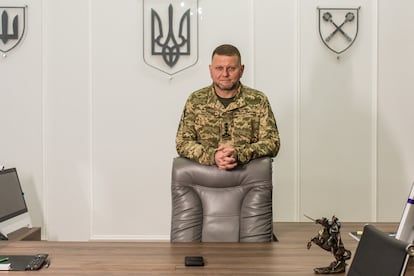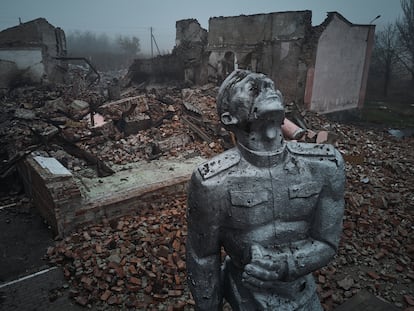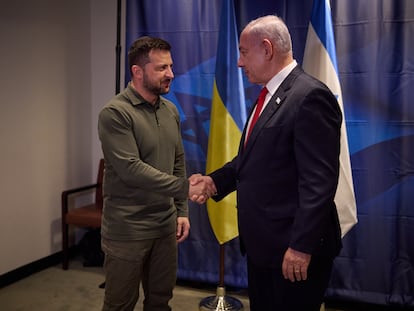Ukrainian commander-in-chief admits the war against Russia is at a stalemate
Valerii Zaluzhnyi predicts that there will be no progress for at least a year and has compared the situation at the front to World War I

Valerii Zaluzhnyi is held in so much respect in Ukraine that he can speak frankly like no one else. Not even the president, Volodymyr Zelenskiy, can be as candid as the commander-in-chief of the Armed Forces of Ukraine. Zelenskiy would not praise an enemy, as Zaluzhnyi did in a September 2022 interview with Time, in which he said that the smartest military theoretician in existence is his greatest rival, Valery Gerasimov, chief of the Russian General Staff. In an interview with The Economist on Wednesday, Zaluzhnyi admitted that he has made mistakes, that the front has stagnated, and that there is little prospect of the situation changing: “Just like in the First World War we have reached the level of technology that puts us into a stalemate.”
Zaluzhnyi also admits that only with a supply of the most advanced technology from Kyiv’s NATO allies, and in much larger quantities than what has been contributed so far, can the deadlock at the front be broken. “It is important to understand that this war cannot be won with the weapons of the past generation and outdated methods,” the general said. Ukraine has received tens of billions of dollars’ worth of military aid, but mostly in equipment that is not among the most advanced Western defense systems. Armaments such as German Leopard tanks or the future delivery of U.S. F-16 fighters, for example, entered into production in the 1970s.
Zaluzhnyi acknowledges that this new phase of support is unlikely to occur in the near future, so the stalemate on the front will remain in place. “There will most likely be no deep and beautiful breakthrough,” Zaluzhnyi told The Economist, with characteristic irony.
The Ukrainian commander-in-chief also published a short essay in the British magazine, in which he set a period of at least a year during which his troops will lack the necessary armaments to make significant progress. “[Russia] will have superiority in weapons, equipment, missiles and ammunition for a considerable time,” wrote the general. “Our NATO partners are dramatically increasing their production capacity, too. But it takes at least a year to do this and, in some cases, such as aircraft and command-and-control systems, two years.”
Kyiv has been warning for weeks that NATO’s stockpiles are running low and that Western military industry production will not be able to meet sufficient Ukrainian demand for new large-scale operations. Mikola Bielieskov, an analyst at the Institute for Strategic Studies, made this clear in an October 16 report published by the U.S.-based Atlantic Council: “Projected production is unlikely to meet Ukraine’s needs until the second half of 2024 or early 2025 […] Anticipated supply shortfalls in key munitions will likely shape Ukraine’s strategic thinking for next year’s spring and summer campaigning seasons.”
Continued international support for a war lasting years is also not assured. Zelenskiy acknowledged last Tuesday, in an interview with Time, that war weariness is taking hold of Western governments and societies: “Exhaustion with the war rolls along like a wave. You see it in the United States, in Europe.” The Ukrainian leader admits that he is under pressure to negotiate a ceasefire, but has ruled it out because it would signify “leaving an open wound for future generations.”

End of Ukrainian counteroffensive
Zaluzhnyi’s analysis confirms the end of the counteroffensive that Ukraine launched in June, and on which both Kyiv’s allies and Ukrainian citizens had placed enormous hopes. In five months, the Ukrainian push has only advanced about 10 kilometers (6.2 miles) in the direction of the Sea of Azov, through a very vulnerable corridor. The initial objective was to recapture the city of Melitopol and from there cut the Russian logistical lines in the east and advance toward Crimea. But Melitopol remains almost 80 kilometers (50 miles) beyond the front line. The Crimean Peninsula, occupied by Russia since 2014, is 100 kilometers (62 miles) from the nearest Ukrainian positions, in Kherson province.
Zaluzhnyi admits to having made mistakes, for example, by relieving commanders he considered were responsible for the lack of results. The first three months of the counteroffensive on the Zaporizhzhia were catastrophic, according to multiple military sources consulted by EL PAÍS: the high command opted to try to break the Russian defensive lines with assaults involving large columns of armored vehicles and infantry. The minefields and Russian fortifications, reinforced to an extent not been seen on a battlefield since World War II, halted these attacks, leaving hundreds of casualties and destroyed vehicles.
The conflict has since been based on “positional warfare,” as Zaluzhnyi explains: “The war has entered a new phase, what in the military world we call positional warfare, of static fire and attrition, as in World War I, in contrast to a war of maneuver, of movement and speed.” The situation, says the general, “will benefit Russia, allowing it to rebuild its military power, eventually threatening Ukraine’s armed forces and the state itself.”
Above all, Zaluzhnyi notes, Ukraine has been assisted by its allies to resist the invasion, but not to win the war. While in Washington and Europe there were doubts about what weaponry to send, Russia was erecting hundreds of miles of impregnable triple defensive lines. The Ukrainian commander-in-chief even points out that the F-16 fighters will arrive too late because Russia’s anti-aircraft defenses are increasingly superior. Zaluzhnyi also revealed a hitherto secret fact: of the 120 warplanes that the Ukrainian Air Force had at the beginning of the invasion, only 40 remain in service.
Moscow’s response
The Kremlin spokesman, Dmitry Peskov, said Thursday that the war is not static and that Russia will continue with its “special military operation” to expel the Ukrainian army from the eastern provinces that Moscow wants to annex illegally. Despite Peskov’s statements, one of Vladimir Putin’s main allies, Belarusian President Aleksandr Lukashenko, said last week that the war has reached a stalemate and that neither side has the strength to tip the balance.
Zaluzhnyi admits another mistake, and that is to have believed that the war would eventually take its toll on Putin: “That was my mistake. Russia has lost at least 150,000 dead. In any other country, such casualties would have stopped the war.” The Kremlin has something fundamental that Ukraine does not have: a vast supply of human assets. Zaluzhnyi also stressed this in calling for more and better weaponry “to accelerate victory, because sooner or later we are going to find that we simply don’t have enough people to fight.”
Sign up for our weekly newsletter to get more English-language news coverage from EL PAÍS USA Edition
Tu suscripción se está usando en otro dispositivo
¿Quieres añadir otro usuario a tu suscripción?
Si continúas leyendo en este dispositivo, no se podrá leer en el otro.
FlechaTu suscripción se está usando en otro dispositivo y solo puedes acceder a EL PAÍS desde un dispositivo a la vez.
Si quieres compartir tu cuenta, cambia tu suscripción a la modalidad Premium, así podrás añadir otro usuario. Cada uno accederá con su propia cuenta de email, lo que os permitirá personalizar vuestra experiencia en EL PAÍS.
¿Tienes una suscripción de empresa? Accede aquí para contratar más cuentas.
En el caso de no saber quién está usando tu cuenta, te recomendamos cambiar tu contraseña aquí.
Si decides continuar compartiendo tu cuenta, este mensaje se mostrará en tu dispositivo y en el de la otra persona que está usando tu cuenta de forma indefinida, afectando a tu experiencia de lectura. Puedes consultar aquí los términos y condiciones de la suscripción digital.
More information
Archived In
Últimas noticias
Alain Aspect, Nobel laureate in physics: ‘Einstein was so smart that he would have had to recognize quantum entanglement’
Imelda Castro, the woman who wants to rule the cartel battleground of Sinaloa
The new victims of the Republican war on Obamacare: Millions hit by soaring health insurance premiums
A country divided on migrant rights: Some US states expand protections while others restrict them
Most viewed
- David King, chemist: ‘There are scientists studying how to cool the planet; nobody should stop these experiments from happening’
- Reinhard Genzel, Nobel laureate in physics: ‘One-minute videos will never give you the truth’
- Oona Chaplin: ‘I told James Cameron that I was living in a treehouse and starting a permaculture project with a friend’
- Sinaloa Cartel war is taking its toll on Los Chapitos
- Mexico completes its trade shift with the entry into force of tariffs on China and countries without trade agreements











































